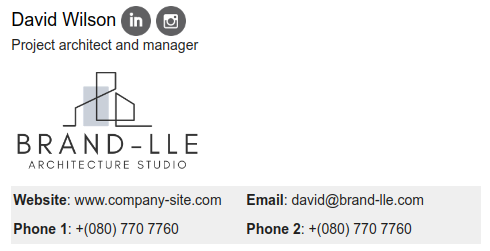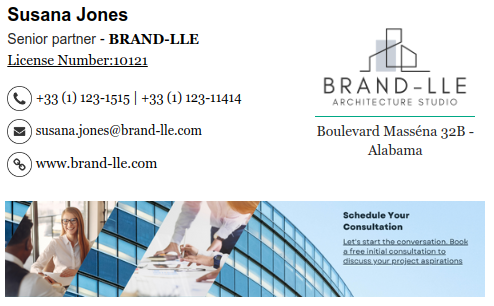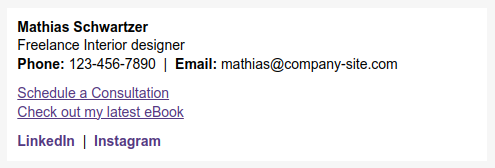This post is also available in: Português
From small companies to multinational architectural corporations, email is a primary mode of communication, mainly in architectural offices and architects.
As such, the importance of a well-crafted email signature cannot be overstated. It enhances the professional image, promotes the brand, and even acts as a marketing tool.
In this comprehensive article, we will dive into the world of business email signatures, with a particular focus on examples for architectural offices and architects.
Understanding the importance of an email signature in the architecture business
The importance of a business email signature goes beyond just providing your contact information. It’s a reflection of your professional identity and can significantly influence how your recipients perceive you and the business.
A well-designed email signature can inspire trust, demonstrate professionalism, and even boost conversions.
For companies in the architecture and architects sectors, an email signature can serve as a powerful tool to showcase their expertise, highlight their portfolio, and establish credibility.
It can also be an effective way to direct recipients to your website or social media profiles, thus increasing your visibility and online engagement.
Professionalism and branding
An email signature should be consistent with your other branding elements, such as the logo, color scheme. This consistency helps reinforce the brand identity and makes emails instantly recognizable to your recipients.
In architectural offices or for architects, this can be particularly beneficial. By inserting elements such as the logo, a project banner, or design sketches at the end of the HTML signature, you can create a visual impact that differentiates you from your competitors and leaves a lasting impression on your recipients.
Marketing
Business email signatures can also serve as subtle but effective marketing tools.
By including links to your website, blog, or social media profiles, you can direct traffic to these platforms and increase your online visibility. This can be particularly useful for architectural offices and architects, by allowing you to showcase your portfolio and attract potential clients.
In addition, by adding a call to action (CTA), such as “Schedule a Consultation” or “See Our Latest Project,” you can encourage your recipients to engage with your business and potentially convert them into clients.
Creating an effective architect email signature
Creating an email signature requires careful consideration of several elements. From the information you include to the design and layout, each aspect plays a crucial role in determining the effectiveness of your email signature.
For architectural offices or architects, the email signature should reflect your professional identity and highlight your expertise and services.
Here are some key elements to consider when creating your business email signature.
Essential information
Your HTML signature should include all the essential information that your recipients may need. This typically includes your name, job title, company name, contact information (phone number, email address), and website URL.
For architects, you might also want to include additional information, such as your professional license number, awards or recognitions, and links to your portfolio or project images.
Clean design
The design of the email signature should be clean, professional, and easy to read. Avoid overloading your signature with too much information or overly complex details.
Instead, opt for a simple and streamlined design that allows your recipients to quickly find the information they require.
For architectural offices and architects, consider incorporating visual elements that reflect your industry, such as architectural icons, building symbols, or project images. However, make sure these elements enhance your signature rather than distract from the essential information.
Examples of email signatures for architectural offices and architects
Now that we’ve discussed the importance of business email signatures and how to create them, let’s take a look at a few more examples specifically tailored for the architecture industry.
These examples demonstrate how you can effectively incorporate your professional identity, expertise, and services into your email signature while maintaining a clean and professional design.
Social media platforms, specifically LinkedIn and Instagram, are extremely popular and commonly used by architecture professionals.
They offer a platform to share projects, ideas, and collaborate with other professionals in the industry. In addition, these platforms are also used for networking and to stay updated on the latest trends and innovations in the field of architecture.
So, it’s a good idea to add them to the email signature.

Including a web banner in an email signature is highly beneficial for architecture professionals. This visual representation of their work right in the email enhances its appeal. Furthermore, a well-crafted banner can boost credibility and project a professional image.

Example minimalist
The idea of a minimalist email signature for an architect is also acceptable. You can use it in internal communication with work colleagues.

An example with simple text but with a CTA link, see here more examples like this.

Conclusion
In conclusion, a well-crafted business email signature can significantly enhance your professional image, promote services, serving as a marketing tool.
With an HTML signature, architecture firms, architects, and industry professionals can have an effective way to showcase their expertise and services, attract potential clients and increase their online visibility and engagement with email.
By understanding the importance of email signatures in business, you can ensure that your email communications reflect your professional identity and align with your business goals.

Create your first email signature with Bybrand
Bybrand offers the ability to generate, administer, and distribute essential email signatures for your employees.